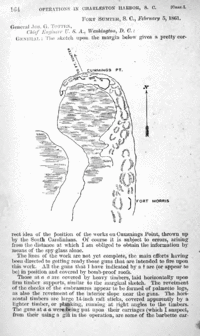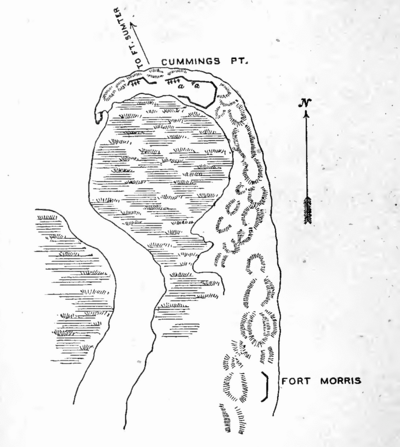From Warriors of the Rebellion
Jump to navigationJump to search
| February 5, 1861 - Captain John Foster to General Joseph Totten
|
 Click for full-sized scanned image  Click for full-sized scanned image Union Correspondence, etc.
FORT SUMTER, S.C., February 5, 1861.
General JOS. G. TOTTEN,
Chief Engineer U.S.A., Washington, D.C.:
GENERAL: The sketch upon the margin below gives a pretty cor-

rect idea of the position of the works on Cummings Point, thrown up by the South Carolinians. Of course it is subject to errors, arising from the distance at which I am obliged to obtain the information by means of the spy-glass alone.
The lines of the work are not yet complete, the main efforts having been directed to getting ready those guns that are intended to fire upon this work. All the guns that I have indicated by a + are [or appear to be] in position and covered by bomb-proof roofs.
Those at a a are covered by heavy timbers, laid horizontally upon firm timber supports, similar to the marginal sketch. The revetment of the cheeks of the embrasures appear to be formed of palmetto logs, as also the revetment of the interior slope near the guns. The horizontal timbers are large 14-inch raft sticks, covered apparently by a lighter timber, or planking, running at right angles to the timbers. The guns at a a were being put upon their carriages [which I suspect, from their using a gin in the operation, are some of the barbette carriages from Castle Pinckney or Fort Moultrie] at the time I wrote to you this morning. Subsequently the rough opening of the embrasures was made and the revetment of the cheeks commenced.

The second bomb proof battery is built differently. The timbers on top are sloped at an angle of 45, about as in the sketch. They rest

upon two horizontal supports parallel to the direction of the battery, one higher than the other, and these are supported by stout posts, about 5 feet from each other. Upon the timbers are placed at right angles a stout planking, and upon this again another covering running up and down. This last consists of railroad iron, apparently the T rail. The work has only progressed thus far, although there is no doubt that the whole is to be covered with sand. The guns are mounted and the openings for embrasures formed.
The work is carried on quite rapidly, considering the heavy nature of the work. The idea of covering the bomb-proof with iron and giving it an inclination is no doubt derived from the Sardinian method for forming the sides of a man-of-war, so as to deflect the shot.
A large force of negroes is employed in extending the embankment of the parapet so as to connect this battery with the field work.
The guard-boats are very active at night, and some are always on the watch by day.
Inside this fort the work of preparation goes steadily on. My force is now employed in clearing the parade of the stone flagging. I am also having all the material on hand made into sand bags.
Very respectfully, your obedient servant,
J.G. FOSTER,
Captain, Engineers.
(To view this page in its Source Category, click HERE for Part 1 and HERE for Part 2)
|